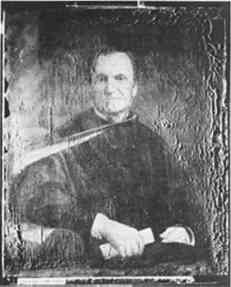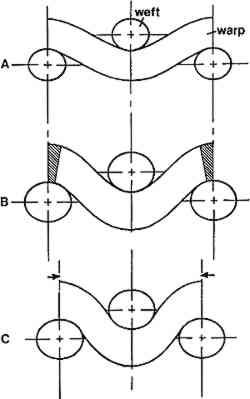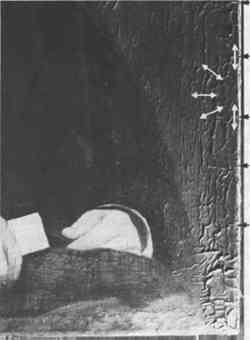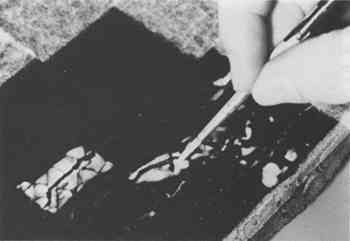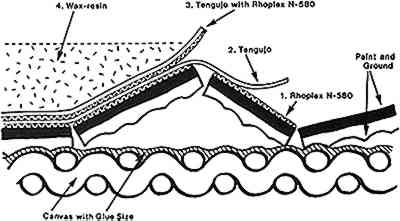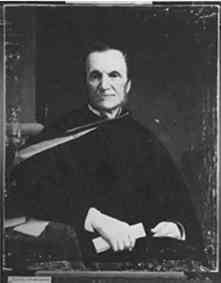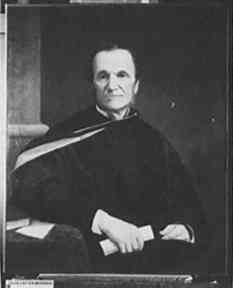USE OF A PRESSURE-SENSITIVE ADHESIVE TO FACILITATE THE TRANSFER OF A SEVERELY TENTED PAINTINGGIANFRANCO POCOBENE, & IAN HODKINSON
ABSTRACT—This paper describes the conservation and restoration of a late 19th-century oil on canvas that was badly damaged in a flood. The portrait of the Rev. Professor James Williamson was painted by William Sawyer in 1887. Water damage left much of the painting with severe, complex tenting patterns and in an extremely brittle, perilous condition. The materials and construction of the painting—a tightly woven canvas, a discrete glue size layer, and a thin and brittle ground and paint film—all contributed to the severity of the damage. A description of the mechanisms that cause tenting and flaking of the image layers away from the canvas is also given.The multiple problems of severely distorted paint film and irreversibly shrunken canvas support led to the discarding of traditional conservation approaches and the development of a novel treatment procedure. Essential to the success of the procedure was the use of an acrylic pressure–sensitive adhesive dispersion (Rhoplex N-580). The tented and detached paint and ground layers were secured with Japanese paper (tengujo) using this adhesive in a modified facing procedure. After further consolidation, the original canvas support was removed, and the paint layers were returned back to plane without overlap on the vacuum hot table. The treatment was completed with the reattachment of the paint layers to a new support, varnish removal, and final retouching. 1 INTRODUCTIONPaintings conservators are well aware of both the beneficial and the deleterious effects of moisture on canvas-supported oil paintings. While the prudent use of moisture during treatment can significantly reduce paint layer distortions such as cupping, draws, and dents, excessive amounts of water can be devastating to the structure of a canvas painting. In both instances water is absorbed by the painting, yet the results are dramatically different. Damage from excess water can include blooming and blanching of the varnish and paint film, detachment of an old lining, and tented cleavage of the paint and ground layers. In extreme situations of total saturation, some canvas paintings exhibit almost complete disintegration of the image layers. This paper deals with a canvas painting severely damaged in a flood and its subsequent conservation and restoration. While paintings from any period can be damaged by water, the picture in question is typical of a group of 19th-century paintings that are highly susceptible to water damage. These paintings, executed on commercially primed fabrics, are constructed in a manner that greatly increases the possibility of canvas shrinkage and damage to the paint and ground layer. This study also describes the mechanical response of canvas paintings to water saturation. In August 1984, during building alterations, water from a prolonged heavy rainstorm entered the storage vault of the Agnes Etherington Art Centre at Queen's University in Kingston, Ontario, Canada. A number of paintings in the collection were damaged in that flood disaster. One picture, a 19th-century portrait in oil on canvas, illustrates the extent of damage that can
After removal from the storage vault the painting showed signs of complete disintegration as it began to dry. Further damage was prevented by promptly placing it in a humidity chamber at 70% RH. The painting was kept at that constant humidity level to avert further compression of the paint layers. So critical was the painting's condition that it remained in the humidity chamber while treatment options were considered. 2 PAINTING STRUCTURE AND CONDITIONThe painting, measuring 93.0 � 77.3 cm, was attached to a four-membered softwood stretcher with metal tacks spaced 4–6 cm apart. The picture was executed on a fine, tightly woven, plain-weave linen canvas having a thread count of 15 warp and 14 weft yarns per cm. Both of the yarns had z-twists. Selvage edges were extant on both the left and right edges of the canvas; the warp yarns had a vertical orientation. Microscopic examination revealed that a glue size layer had been applied to the linen canvas before priming. Under magnification the glue size appeared as a distinct layer that coated the yarns of the canvas. The canvas was commercially primed with a thin, off-white oil ground, and the image layers were executed with pigments in a drying oil medium. Examination under ultraviolet light confirmed the existence of extensive overpaint along the left side and bottom edge. The painting had a surface coating of natural resin varnish, which was moderately discolored and partially blanched. The flood damage resulted in major alterations to each layer of the painting. The canvas was extremely weak and degraded; although it had undergone considerable shrinkage and tightening upon wetting, it was slack on its stretcher after drying. There were numerous tears along the turnover edges and tacking margins, many originating from the tack points. The paint and ground layers exhibited large amounts of tented cleavage; although these layers were severely distorted and very brittle, To comprehend why this type of damage occurs in some paintings more than in others, it is necessary to examine how each of the painting components react to water and how they interact with each other. 3 FABRIC SHRINKAGE IN HIGH MOISTURE LEVELSIt is well known that certain fabric supports, especially tightly woven ones, are susceptible to shrinkage at high moisture levels. An inherent characteristic of cellulosic fabrics, notably those produced since the mid-19th century, is their shrinkage response to wetting. In conservation these canvas supports are often termed “shrinkers.” While conservators have learned empirically to be wary of this type of canvas when undertaking moisture treatments, the mechanism that causes a canvas to shrink in high moisture levels is generally not well understood.Like all organic materials, the cellulosic fibers in linen and cotton fabrics swell as they absorb moisture. This swelling leads to an increase in the diameter of the yarns that make up the fabric. But surprisingly, as the yarns expand at high moisture levels, the canvas itself shrinks. To understand this phenomenon, the mechanisms of this process need to be examined in some detail. The fundamental mechanisms of fabric shrinkage as a result of water saturation were explained by Collins (1939). Although that important study examined only the behavior of cotton, Harwood (1936) noted that linen fabrics could be expected to behave similarly. It was found that as water was absorbed into the fabric the transverse swelling of the fibers and yarns induced shrinkage in three ways: longitudinal fiber shrinkage, yarn shrinkage, and crimp accentuation. It is the third mechanism, however, that accounts for most of the canvas shrinkage. The uptake of water by canvas fibers and yarns results in relatively large increases in their diameters (in typical cotton yarns, increases of 10% can be expected). Nevertheless, transverse swelling of fibers results in longitudinal shrinkages of only 1%. Yarn shrinkage, which is related to the degree of twist imparted on the yarn during spinning, can give rise to more shrinkage but accounts for shrinkages of only 2% in typical fabrics (Collins 1939). Hence, the shrinkage in the Sawyer portrait can be explained only by the crimp accentuation phenomenon. The mechanism of crimp accentuation is illustrated in figure 2. Figure 2A represents the position of warp and weft yarns in an unrestrained fabric before wetting. When the fabric is wetted, swelling of both the yarns results. For the fabric to maintain the same external dimensions it had before wetting—that is, not shrink at all—the warp yarns would have to extend a given length (fig. 2B). The extension that would be necessary for the warp yarns to travel around the swollen weft yarns is represented by the shaded areas. There is an energetically simpler mechanism that accommodates the increased path of the warp yarns (fig. 2C). In this mechanism, the weft yarns move closer together and the warp path length remains the same. Likewise, an increase in the diameter of the weft yarns results in movement of the warp yarns closer together. For this reason, shrinkage of the fabric in both directions is observed. From this description it is clear that construction has a significant bearing on a fabric's response to wetting. The degree of yarn twist, yarn diameter, and sizing have some influence, but the spacing of yarns (degree of crimp) is the most critical factor. Thus, the closer the yarn spacing and the more compacted the yarns, the
This mechanism of shrinkage in unrestrained fabrics also occurs in partially restrained fabrics such as the canvas support of a painting. There, movement is inhibited at the tack points but the rest of the fabric is free to respond to the internal forces generated. 4 THE ROLE OF THE GLUE SIZE LAYERIn the Sawyer painting, large areas of the ground and paint film were delaminated from the canvas support. Examination of the canvas revealed that it had been sized with an animal glue before the application of the ground layer. This technique is typical of commercially prepared artist's canvas of the 19th century. In paintings susceptible to water damage the canvas support usually begins to shrink 2–3 minutes after wetting. Because the forces would also be transferred to the ground and paint layers, one might expect that compression damage to these layers would occur immediately at the onset of canvas shrinkage. However, there is usually a delay of some 5–10 minutes before the paint layers undergo compression damage.1 This interval between the canvas shrinkage and the beginning of tented cleavage is significant. The reason for the delay is that the glue size layer is slower to absorb water and soften. Once the glue size has softened and adhesion between the canvas and ground is lost, compression damage to the more rigid paint and ground layer occurs. Moreover, the manner in which the glue size was applied to the canvas may play an important role in the delamination process. In the Sawyer painting, microscopic examination revealed that Several factors accounted for such severe and extensive damage to the Sawyer painting. First and foremost was the phenomenon of canvas shrinkage producing high compressive forces. Second, the damage was exacerbated by the presence of a discrete glue size layer that lost its adhesive strength as it gelled and allowed the ground layer to release from the canvas. Third, the thin, brittle paint and ground layers, too weak to resist the compressive forces generated by the shrinking canvas support, were fractured and tented out of plane. This phenomenon of rapid canvas shrinkage followed by delamination of the paint layer was also reported by Hedley (1988). 5 PATTERNS OF DAMAGE IN THE SAWYER PAINTINGAn examination of the tenting patterns formed in this painting reveals how the forces were generated in the painting as it reacted to the water. The most acute canvas shrinkage occurred near the perimeter of the painting (fig. 1), with the exception of the top left corner, which may not have been totally saturated. One possible explanation for this pattern is that the canvas was first wetted at the edges from contact with the stretcher bars. The soaked stretcher may also have kept the edges of the canvas wet for a longer period softening the glue size at the edges more than in other areas. A second possibility is that the greatest shrinkage forces were formed along the perimeter. This observation accords with research by Hedley (1975), which indicates that the stresses generated at the corners and edges of a painting are greater than those in the center. Tenting was generally less severe toward the center. Of interest, however, was the predominantly vertical orientation of the tenting. One or more structural differences between the warp and weft yarns—such as thread count, yarn diameter, degree of twist, and perhaps sizing at the time of weaving—may have caused the warp yarns to move closer together, resulting in more crimping of the weft yarns and greater shrinkage of the canvas in the horizontal direction. One area in the center of the painting above the sitter's left shoulder (fig. 1), which had received a blow at an earlier time, exhibited severe tented cleavage. Areas immediately surrounding this dent, however, were less affected. It would appear from this feature that prestressed and cracked paint layers are more prone to be lifted out of plane. At the right tacking margin, where paint film damage was most severe, scallop-shaped patterns of tented cleavage were also observed (fig. 3). Remarkably, a tent emanated from each tack, then curved back in a series of tents to its neighboring tack point. Since the tents are formed perpendicular to the principal direction of the compression forces generated by the shrinking fabric, a reconstruction of the direction of shrinkage forces in the painting is possible (fig. 3). This pattern resulted from differences in the magnitude and direction of stresses at the tack points and between them. Between the tack points, the predominant forces were generated perpendicular to the painting edge. These stresses were released as tents formed parallel to the edge. Just above the tack points, however, the movement of the canvas toward the center was restricted by the tacks. Here, the shrinkage occurred
Surprisingly, areas of overpaint—which, ironically, represent restorations probably connected with earlier water damage—remained unaffected by the water. The restorations in oil covered numerous voids along the left edge and more extensive losses along the bottom edge. Perhaps earlier loss of glue size layer or heavy consolidation in the previous restoration prevented canvas shrinkage and paint detachment. 6 CONSERVATION TREATMENTPreliminary investigations into the problem made it clear that methods usually employed to treat this type of severe damage would prove inadequate and result in further loss. Only after considered reflection and experimentation was a treatment procedure devised. In keeping with the principal of minimal intervention, options were considered that would allow retention of the original canvas support. Attempts were made to plasticize the structure by further controlled humidification to allow expansion of the canvas and re-laying of the detached paint. However, the magnitude of shrinkage and brittleness of the paint layers made this option not only hazardous but impossible. The paint and ground layer remained brittle in spite of slowly raising the RH to 78%. The canvas also began to tighten noticeably at this humidity level.2 Raising the RH any higher would return the painting dangerously close to the conditions that caused excessive crimping of the canvas in the first place. It was concluded that any attempt to stretch the canvas with the aid of moisture—by means of the Dutch stretcher method for example—would result in additional cleavage and paint loss. Furthermore, because shrinkage had occurred in a heterogeneous manner, forming tents perpendicular to each other at the edges and corners of the badly degraded canvas, simple outward expansion of the canvas would not reverse the complex distortion patterns. In the end, to save the whole image, it became clear that transfer would be the only option. Even after the decision was made to transfer, a number of perplexing problems remained. Given the condition of the painting, the most important part of the procedure was the choice of facing materials and technique. Attempts to face the paint film in this state using traditional techniques would have resulted in overlapping
As we continued to reflect on the problem of devising a suitable facing procedure, the use of pressure-sensitive adhesives in the lining of paintings came to mind (Fieux 1984; Gransow 1984). Pressure-sensitive adhesives in the form of precast films on a tissue substrate were contemplated, but they were rejected because of foreseeable problems in their manipulation during application. If the tissue were to inadvertently adhere in the wrong position, for example, it would have been extremely difficult to remove it from the fragile paint. After considerable testing, a novel facing procedure was devised that provided maximum control and met all of the necessary requirements. This procedure involved the use of Rhoplex N-580, a pressure sensitive adhesive, and tengujo, a Japanese paper. Rhoplex N-580 is an aqueous dispersion of butyl acrylate copolymerized with acrylic acid (CCI 1981; Haywood 1988). When applied to a surface, it drys to a transparent tacky film. Bonding of a material to a surface coated with the adhesive is effected by means of gentle pressure. The tengujo paper was chosen for its fineness, strength, and ability to conform to the distorted topography of the damaged paint surface. Preliminary tests on Rhoplex N-580 indicated that it possessed the necessary adhesive strength for the facing procedure. Tests to determine its stability during and after heating were also carried out. Heating the adhesive to 70�C did not reduce its adhesive strength, and after heating it remained soluble in mixtures of alcohol and ketone solvents, previously determined as safe for the paint layers. Therefore, the adhesive would not release during subsequent treatment on the hot table and could later be removed with little difficulty. 7 FACING PROCEDUREAssured by the results of the preliminary tests we proceeded to the treatment of the painting. Loose paint chips trapped between the cleaved ground layer and the canvas were retrieved with tweezers, documented, and saved for reattachment. Sections of the painting were coated with a thin layer of Rhoplex N-580 using a no. 2 sable brush (fig. 4). The adhesive had a tendency to solidify as globules on the end of the brush during application. Therefore, periodic cleaning of the brush with acetone was necessary to remove the drying adhesive and avoid handling difficulties. Sections of the tengujo
Because of the brittle condition of the paint film, it was decided that a second facing layer should be applied for additional support and strength. Unfortunately, application of the pressure-sensitive adhesive in dispersion form to a small test area of the first facing layer resulted in absorption of the adhesive into the facing and loss of tacking strength. Instead, the earlier idea of applying the adhesive in the form of a precast film on the tissue was used. The Rhoplex N-580 was cast by brushing a thin, even layer of the adhesive onto a large sheet of silicone-release paper pinned to a flat surface. Once the water phase of the Rhoplex N-580 had evaporated, sections of the tengujo paper (approximately 20 � 20 cm) were attached to the tacky film by laying down one edge of the paper and slowly contacting the rest of the paper with a brush. The formation of creases was avoided during this step. The tengujo paper, now with a film of the pressure-sensitive adhesive on one side, was cut in sections larger than the first facing layer but varing in size according to the extent of planar distortion in a given area. The silicone-release paper was peeled away and these sections were then applied over the first layer, again closely following the surface distortions in the painting by means of gentle pressure with a brush (fig. 6).
With the paint and ground layers secured by facing, it was now necessary to remove the canvas support and return the paint layer to plane. Wax-resin in combination with heat was chosen to facilitate the task. A wax-resin facing system based on a facing procedure developed by Keck (1981) was used. Molten wax-resin (8 parts beeswax, 2 parts Ketone Resin N, and 1 part microcrystalline wax W445) was brushed onto the facing layer to a thickness of approximately 5 mm (fig. 6). This system had three functions. First, because the wax-resin conformed exactly to topographical distortions in the paint film, it provided additional support and stiffness. Second, the molten wax-resin would act as a plasticizer during manipulation of the paint film back to plane while on the hot table. And third, the wax-resin would be the adhesive to attach the transferred painting to its new support. To properly secure the painting during removal of the stretcher and canvas, a sheet of Mylar (1 mil), cut larger than the outer dimensions of the faced painting, was laid over the wax-resin layer and attached with a warm tacking iron. The painting was then placed face down and the stretcher removed. To prevent movement of the painting during canvas removal, the edges of the Mylar sheet were pulled taut and secured to a smooth board against which the face of the painting rested. 8 CANVAS REMOVAL AND MANIPULATION OF TENTED PAINT BACK TO PLANEThe weak canvas support was easily pulled away by hand because the adhesion between the Manipulation of the tented paint and ground layer back to plane was executed on the hot table. The faced painting, now minus its canvas support, was placed face down on the hot table, with the Mylar still attached. Heat from the hot table was used to melt the wax-resin slowly. A loose Mylar sheet was then placed over the reverse of the painting. By means of gentle pressure with the fingers and cotton wads, the tented cleavage was reduced by working the tents outward from the center. The excess wax-resin that flowed out was absorbed with large cotton wads leaving a thin layer on the paint film. It was not possible to reduce the tents completely because the paint layers, having been tented for some time, had acquired a degree of plastic memory. Therefore, after cooling, the procedure was repeated by placing the painting face up on the hot table in a vacuum envelope. Once again, heat and the gentle pressure of the fingers and cotton wads were applied to the tents. The tents that remained were thus further reduced. The flexibility of the facing adhesive and the method of its application permitted expansion of the entire structure back to plane without paint film overlap. 9 TRANSFER ONTO NEW SEMI-RIGID SUPPORTTo prevent the possible return of the tents, a semi-rigid support composed of a fine-weave, 50–50 polyester–cotton interleaf fabric and a stiff Dacron polyester sailcloth (Aquino 8.25 oz) was prepared. The laminate was bonded with a layer of Beva 371. In preparation for transfer of the paint and ground layer, the lining support was also infused with wax-resin. The paint layers were adhered to the lining support under vacuum on the hot table, and local pressure was again applied to the tented areas. After reattachment of the paint film to its new support, excess wax-resin was removed from the surface of the painting with cotton swabs charged with Stoddard solvent. As expected, the adhesive held the facings and paint layers throughout the treatment on the hot table. 10 REMOVAL OF FACINGS, PRESSURE-SENSITIVE ADHESIVE, AND VARNISHTo remove the facings, the Rhoplex N-580 was gelled by the application of a 1:1 mixture of 2-propanol and Stoddard solvent. The facing tissues were then carefully pulled away. Residues of the remaining contact adhesive were removed with cotton swabs charged with a 2:1 mixture of 2-propanol and acetone. This procedure caused the unavoidable partial removal of the varnish layer. The remaining discolored varnish layers were removed with a 2:1 mixture of 2-propanol and acetone. In this case, the removal of the yellowed and blanched varnish layer was a desirable part of the treatment. In other instances where the retention of the varnish is desirable, the selection of Rhoplex N-580 as a facing adhesive should be considered carefully given the solvents needed to remove it. 11 RESTORATIONBefore the painting was attached to a newly constructed pine stretcher, the loose paint chips retrieved from the painting before treatment were reattached with wax-resin using a warm tacking iron. After the painting was attached, a thin, isolating layer of B-72 (10% in xylenes) was sprayed onto the surface. Minor losses were filled with a gesso of calcium carbonate in rabbit
12 CONCLUSIONSConservators have developed a number of treatment methods for dealing with severely damaged paintings. Among these are the procedures of facing and transfer of the paint film from an irreparably damaged or deteriorated support. Only dire circumstances warrant such major intervention, but such circumstances do arise. In the treatment described, traditional facing procedures would not have sufficed. The multiple problems of severe tented cleavage, disintegrating paint film, and irreversibly shrunken and degraded canvas support necessitated an innovative facing procedure. Fortunately, While the long-term stability of Rhoplex N-580 remains to be investigated, the facing procedure described here may prove a valuable solution to otherwise insolvable problems. The adhesive may also have broader applications in the conservation of works of art. ACKNOWLEDGEMENTSWe wish to express our thanks to Robert Swain and Dorothy Farr of the Agnes Etherington Art Centre, Queen's University, Kingston, Ontario, Canada, for their interest and support during the conservation and restoration of the painting. The contents of this paper were presented to the Paintings Specialty Group at the 17th annual meeting of the American Institute for Conservation of Historic and Artistic Works in 1989. NOTES. A number of simple tests in the laboratory simulated this process and were revealing about the phenomenon. Fabrics of similar weight to the Sawyer painting were attached to wood stretchers and either left unsized, sized hot with a 5% rabbit skin glue using a brush, or sized cold with the same glue using a spatula. The fabrics were then coated with a layer of calcium carbonate in dammar varnish, which dried for 1 month to a brittle film. These test fabrics were then subjected to fluctuations of relative humidity to induce random cracking patterns. They were then soaked in water and monitored to record the times at which physical changes occurred. NOTES. Reaction of the painting to a moderately high moisture level of 78% RH indicates that conservators should exercise the greatest caution when carrying out moisturizing treatments, whether localized misting or treatments in humidity chambers. REFERENCESBell, M.1978. William Sawyer, portrait painter. Kingston, Canada: Agnes Etherington Art Centre, Queen's University. CCI. 1981. Adhesive Testing Program, Analytical Research Service 1825–1981. Ottawa, Canada: Canadian Conservation Institute. Collins, G. E.1939. Fundamental principles that govern the shrinkage of cotton goods by washing. Journal of the Textile Institute30:46–52. Fieux, R. E.1984. Silicone polymers for relining of paintings. In Adhesives and consolidants, ed.N. S.Brommelle et al. London: International Institute for Conservation. 46–49. Gransow, A.1984. A preliminary investigation into novel adhesive materials for cold-lining paintings. Unpublished research. Kingston, Canada: Art Conservation Program, Queen's University. Gray, K. L.1971. The swelling and shrinkage of untreated fabrics. In Chemical aftertreatment of textiles, ed.H.Mark et al. New York: Wiley-Interscience. 115–33. Harwood, F. C.1936. The problem of shrinkage. Journal of the Textile Institute27:333–44. Haywood, R.1988. Personal communication. Rohm and Haas Canada, Inc., Toronto. January 12. Hedley, G.1975. Some empirical determinations of the strain distribution in stretched canvasses. ICOM Committee for Conservation Preprints, 4th Triennial Meeting, Venice, 75/11/4/1–75/11/4/17. Hedley, G.1988. Relative humidity and the stress/strain response of canvas paintings: Uniaxial measurements of naturally aged samples. Studies in Conservation33:133–48.
Karpowicz, A.1990. A study on development of cracks on paintings. Journal of the American Institute for Conservation29:169–80. Keck, C. K.1981. A white wax facing useful for special circumstances. Unpublished typescript. Cooperstown, New York. SOURCES OF MATERIALSBeva 371Conservation Materials Ltd., 1165 Marietta Way, Sparks, Nev. 89431 Dacron polyester, 8.25 oz.Aquino Sailcloth, City Island, N.Y. (Aquino no longer in business, Bainbridge-Aquabatten, Canton, Mass., supplies Dacron polyester in 8.3 oz. weight). Keytone Resin NBASF product no longer produced Rhoplex N-580Conservation Materials Ltd., 1165 Marietta Way, Sparks, Nev. 89431 Tengujo paperAiko's Art Materials, 3346 N. Clark St., Chicago, Ill. 60657 AUTHOR INFORMATIONGIANFRANCO POCOBENE received his master of arts in conservation at the Art Conservation Programme, Queen's University, in 1984. He was assistant conservator at the Art Conservation Laboratory in Raymond, New Hampshire from 1984 to 1985. He returned to Queen's University to conserve paintings from the collection of the Agnes Etherington Art Centre from 1985 to 1988. During that time he also worked on several mural projects in Canada and was paintings conservator for the Alfred Bader Collection, Queen's University. From 1988 to 1989 he was an intern at the Center for Conservation and Technical Studies, Harvard University Art Museums. He has been at the Center since 1989 and is currently an associate conservator of paintings. Address: Center for Conservation and Technical Studies, Harvard University Art Museums, 32 Quincy Street, Cambridge, Mass. 02138 IAN HODKINSON graduated from Edinburgh University and Edinburgh College of Art with an M.A. in fine art in 1958. He undertook postgraduate studies in 1958 and 1959 at the Central Institute for Restoration in Rome. From 1958 to 1969 he was employed as restorer for the National Trust for Scotland, becoming chief restorer in 1965. He joined the faculty of Queen's University in 1969 and established the master's degree program in art conservation there in 1974. He was head of the Restoration and Conservation Laboratory at the National Gallery of Canada from 1977 to 1979. In 1979 he returned to Queen's University and is currently professor of fine art conservation and director of the Art Conservation Programme. Address: Art Conservation Programme, Queen's University, Kingston, Ontario, Canada K7L 3N6.
 Section Index Section Index |
